We both have read extensively in all subgenres of fiction during the year and, like others who do so, we each have our favorites. Coming up with a list of only 20 books that the two of us could agree upon was a challenge. Here is our notable fiction of 2017 list.
Ages 4–8
Big Cat, Little Cat. Elisha Cooper. 2017. Roaring Brook.
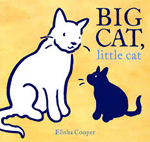 A little black cat comes to live with a big white cat, who shows it “when to eat, / when to drink, / where to go, / how to be, / and when to rest.” Years later, the white cat “had to go … / and didn’t come back.” Loss is hard, but one day a little white cat comes to live with the now big black cat, who shows it “what to do.” A simple text and bold black-and-white illustrations deliver a gentle message about friendship and the cycle of life.
A little black cat comes to live with a big white cat, who shows it “when to eat, / when to drink, / where to go, / how to be, / and when to rest.” Years later, the white cat “had to go … / and didn’t come back.” Loss is hard, but one day a little white cat comes to live with the now big black cat, who shows it “what to do.” A simple text and bold black-and-white illustrations deliver a gentle message about friendship and the cycle of life.
A Greyhound, a Groundhog. Emily Jenkins. Ill. Chris Appelhans. 2017. Schwartz & Wade/Random House.
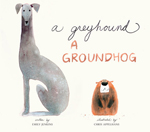 “A hound. / A round hound. / A greyhound. / A hog. / A round hog. / A groundhog.” A greyhound awakes from a nap and a groundhog pops out of its hole to romp “around and around and around / and around!” Exhausted, they settle down together to rest. Full-of-motion illustrations match the rhythmic mix-up of words in this tongue twister of a tale.
“A hound. / A round hound. / A greyhound. / A hog. / A round hog. / A groundhog.” A greyhound awakes from a nap and a groundhog pops out of its hole to romp “around and around and around / and around!” Exhausted, they settle down together to rest. Full-of-motion illustrations match the rhythmic mix-up of words in this tongue twister of a tale.
A Perfect Day. Lane Smith. 2017. Roaring Brook.
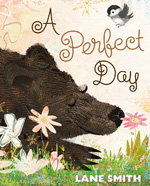 It is a perfect day in Bert’s backyard as Cat lounges among daffodils, Dog sits in the wading pool, and Bert fills the bird feeder for Chickadee and gives Squirrel a corncob. It was a perfect dayfor them until rambunctious Bear lumbers into the yard, and they must scatter as he takes over their perfect place and activities and makes a perfect day for himself. With a playfully repetitive text and colorful mixed-media artwork, Smith explores different points of view as to what makes a perfect day.
It is a perfect day in Bert’s backyard as Cat lounges among daffodils, Dog sits in the wading pool, and Bert fills the bird feeder for Chickadee and gives Squirrel a corncob. It was a perfect dayfor them until rambunctious Bear lumbers into the yard, and they must scatter as he takes over their perfect place and activities and makes a perfect day for himself. With a playfully repetitive text and colorful mixed-media artwork, Smith explores different points of view as to what makes a perfect day.
The Rooster Who Would Not Be Quiet! Carmen Agra Deedy. Ill. Eugene Yelchin. 2017. Scholastic.
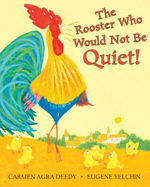 After repeated efforts to silence the rooster’s Kee-kee-ree-Kee! fail, Don Pepe, the mayor of La Paz, threatens to make soup of him. Hearing the rooster’s declaration that he sings for those who dare not sing or have forgotten how to sing, the villagers take up his song and their chorus of Kee-kee-ree-Kee! drives Don Pepe out of town. Yelchin’s sunny mixed-media illustrations are as joyful and humorous as Deedy’s allegorical tale.
After repeated efforts to silence the rooster’s Kee-kee-ree-Kee! fail, Don Pepe, the mayor of La Paz, threatens to make soup of him. Hearing the rooster’s declaration that he sings for those who dare not sing or have forgotten how to sing, the villagers take up his song and their chorus of Kee-kee-ree-Kee! drives Don Pepe out of town. Yelchin’s sunny mixed-media illustrations are as joyful and humorous as Deedy’s allegorical tale.
When’s My Birthday? Julie Fogliano. Ill. Christian Robinson. 2017. Neal Porter/Roaring Brook.
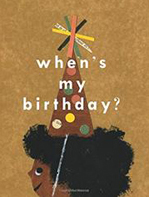 All the excitement surrounding a young girl’s anticipation of her birthday is joyfully expressed in Fogliano’s rhythmic verse (“When’s my birthday? / Where’s my birthday? / How many days until / my birthday?") and Robinson’s colorful acrylic and cut-paper illustrations featuring details of the celebration of this ever-so-important “happy happy” day in a young child’s year.
All the excitement surrounding a young girl’s anticipation of her birthday is joyfully expressed in Fogliano’s rhythmic verse (“When’s my birthday? / Where’s my birthday? / How many days until / my birthday?") and Robinson’s colorful acrylic and cut-paper illustrations featuring details of the celebration of this ever-so-important “happy happy” day in a young child’s year.
Wolf in the Snow. Matthew Cordell. 2017. Feiwel and Friends.
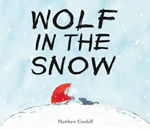 In this mostly wordless book about courage and kindness, a girl in a red jacket, walking home from school through the woods, finds a lost wolf pup and returns him to his pack during a blizzard. In turn, the grateful wolf pack helps in the now lost and exhausted girl’s rescue by her mother and dog. Cordell’s few words (“bark!” “screech!” “huff,” “sink,” “whine,” and “HOOOWWWLL!”) accompany expressive pen-and-ink-with-watercolor illustrations in a wintry palette.
In this mostly wordless book about courage and kindness, a girl in a red jacket, walking home from school through the woods, finds a lost wolf pup and returns him to his pack during a blizzard. In turn, the grateful wolf pack helps in the now lost and exhausted girl’s rescue by her mother and dog. Cordell’s few words (“bark!” “screech!” “huff,” “sink,” “whine,” and “HOOOWWWLL!”) accompany expressive pen-and-ink-with-watercolor illustrations in a wintry palette.
Ages 9–11
Beyond the Bright Sea. Lauren Wolk. 2017. Dutton/Penguin.
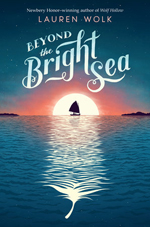 The only life that 12-year-old Crow has known is living on Cuttyhunk (one of the Elizabeth Islands off Cape Cod, Massachusetts) with Osh, the man who rescued her as a newborn from the sea. In this historical novel set in 1925, Crow yearns to know where she is from and who her parents were. Discovering that she came from neighboring Penikese, which had been a leper colony, and exploring the island in search of answers about her background put Crow and the people she loves in danger as she learns the history of her family and the people who lived on the island.
The only life that 12-year-old Crow has known is living on Cuttyhunk (one of the Elizabeth Islands off Cape Cod, Massachusetts) with Osh, the man who rescued her as a newborn from the sea. In this historical novel set in 1925, Crow yearns to know where she is from and who her parents were. Discovering that she came from neighboring Penikese, which had been a leper colony, and exploring the island in search of answers about her background put Crow and the people she loves in danger as she learns the history of her family and the people who lived on the island.
Harry Miller’s Run. David Almond. Ill. Salvatore Rubbino. 2017. Candlewick.
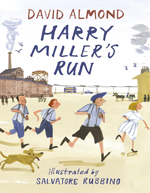 Almond uses a working-class accent in the narration as elderly Harry Miller tells 11-year-old Liam about the 13-mile run he and two mates made from Newcastle to the seaside on a hot summer day in 1938. While recalling details of the memorable run, Harry also imparts words of wisdom regarding a life well lived. “Me great achievement is that I’ve been happy, that I’ve never been nowt but happy.”
Almond uses a working-class accent in the narration as elderly Harry Miller tells 11-year-old Liam about the 13-mile run he and two mates made from Newcastle to the seaside on a hot summer day in 1938. While recalling details of the memorable run, Harry also imparts words of wisdom regarding a life well lived. “Me great achievement is that I’ve been happy, that I’ve never been nowt but happy.”
It All Comes Down to This. Karen English. 2017. Clarion/Houghton Mifflin Harcourt.
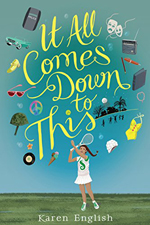 Shy 12-year-old Sophie (budding author and aspiring actor)and her parents are the only black family in their affluent Los Angeles neighborhood. Sophie has made just one friend, her parents are headed for divorce, her sister is leaving for college, and her stern housekeeper does not like her. As Sophie faces personal challenges set against the 1965 historical milieu of the Civil Rights Movement and the Watts Riots, she encounters unexpected kindnesses and also develops courage.
Shy 12-year-old Sophie (budding author and aspiring actor)and her parents are the only black family in their affluent Los Angeles neighborhood. Sophie has made just one friend, her parents are headed for divorce, her sister is leaving for college, and her stern housekeeper does not like her. As Sophie faces personal challenges set against the 1965 historical milieu of the Civil Rights Movement and the Watts Riots, she encounters unexpected kindnesses and also develops courage.
Patina (Track #2). Jason Reynolds. 2017. Caitlyn Dlouhy/Atheneum/Simon & Schuster.
 Twelve-year-old African-American Patina Jones, one of the four newbies (Ghost, Sunny, Lu, and Patina) on the elite youth track team, the Defenders, loves to run—and to win. She knows that she “ain’t no junk” (as she constantly reminds herself), and she’s out to prove this on the track team, at preppy Chester Academy, and in family relationships.
Twelve-year-old African-American Patina Jones, one of the four newbies (Ghost, Sunny, Lu, and Patina) on the elite youth track team, the Defenders, loves to run—and to win. She knows that she “ain’t no junk” (as she constantly reminds herself), and she’s out to prove this on the track team, at preppy Chester Academy, and in family relationships.
Ages 12–14
Crossing Ebenezer Creek. Tanya Bolden. 2017. Bloomsbury.
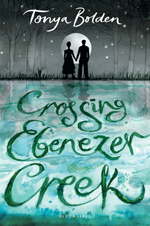 Seeking freedom, Mariah and others enslaved on the Chaney plantation join General Sherman’s 14th Army Corps’ march through Georgia. As a relationship grows between Mariah and Caleb, a free black man working with the corps, she begins to dream of their future together. “Now the struggles of the march were hitched to striving for a new life.” An author’s note provides a context for this story of a little-known event of the Civil War, the tragedy of “the betrayal at Ebenezer Creek” on December 9, 1864.
Seeking freedom, Mariah and others enslaved on the Chaney plantation join General Sherman’s 14th Army Corps’ march through Georgia. As a relationship grows between Mariah and Caleb, a free black man working with the corps, she begins to dream of their future together. “Now the struggles of the march were hitched to striving for a new life.” An author’s note provides a context for this story of a little-known event of the Civil War, the tragedy of “the betrayal at Ebenezer Creek” on December 9, 1864.
A Face Like Glass. Frances Hardinge. 2017. Amulet/Abrams.
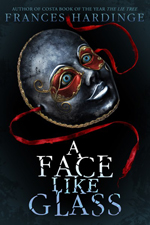 When 12-year-old Neverfall (who has been locked away for seven years by Cheesemaster Grandible and believes she must wear a velvet mask to hide her ugly face) finds a way out of the cheese tunnels in the underground city of Caverna, her “face like glass,” which shows all her thoughts and feelings, puts her in danger as she becomes a pawn of the Court and corrupt ruling families of Caverna.
When 12-year-old Neverfall (who has been locked away for seven years by Cheesemaster Grandible and believes she must wear a velvet mask to hide her ugly face) finds a way out of the cheese tunnels in the underground city of Caverna, her “face like glass,” which shows all her thoughts and feelings, puts her in danger as she becomes a pawn of the Court and corrupt ruling families of Caverna.
Flying Lessons & Other Stories.Ellen Oh (Ed.). 2017. Crown/Random House.
 Short stories, written by ten talented authors (Kwame Alexander, Kelly J. Baptist, Soman Chainani, Matt de la Peña, Tim Federle, Grace Lin, Meg Medina, Walter Dean Myers, Tim Tingle, and Jaqueline Woodson) introduce a diverse group of characters who want to belong and to be accepted for who they are. Back matter includes an “About We Need Diverse Books” section and biographical notes on the contributors.
Short stories, written by ten talented authors (Kwame Alexander, Kelly J. Baptist, Soman Chainani, Matt de la Peña, Tim Federle, Grace Lin, Meg Medina, Walter Dean Myers, Tim Tingle, and Jaqueline Woodson) introduce a diverse group of characters who want to belong and to be accepted for who they are. Back matter includes an “About We Need Diverse Books” section and biographical notes on the contributors.
La Belle Sauvage (The Book of Dust #1). Philip Pullman. 2017. Alfred A. Knopf/Random House.
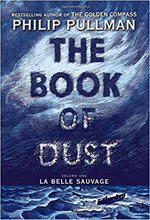 In this first book of Pullman’s new series, set 10 years earlier in the parallel world of the His Dark Materials trilogy, Lyra Belacqua is a baby under the care of nuns in a priory on the Thames. During a devastating flood, 11-year-old Malcolm Polstead rescues Baby Lyra from the destroyed priory in his canoe, La Belle Sauvage. Swept away in the storm, Malcolm faces a long, perilous journey to get Lyra back to safety in Oxford with the aim of securing sanctuary for her at Jordan College.
In this first book of Pullman’s new series, set 10 years earlier in the parallel world of the His Dark Materials trilogy, Lyra Belacqua is a baby under the care of nuns in a priory on the Thames. During a devastating flood, 11-year-old Malcolm Polstead rescues Baby Lyra from the destroyed priory in his canoe, La Belle Sauvage. Swept away in the storm, Malcolm faces a long, perilous journey to get Lyra back to safety in Oxford with the aim of securing sanctuary for her at Jordan College.
Piecing Me Together. Renée Watson. 2017. Bloomsbury.
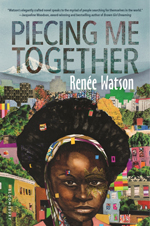 As part of her scholarship to prestigious St. Francis High School on the other side of Portland, Oregon, from where she lives, African-American Jade must participate in a mentoring program called Women to Women although she wonders what her mentor, who appears to have many challenges of her own, can teach her. In learning to appreciate her identity, Jade discovers she wants to develop her talent for collage art and to help people rather than be considered someone who needs help.
As part of her scholarship to prestigious St. Francis High School on the other side of Portland, Oregon, from where she lives, African-American Jade must participate in a mentoring program called Women to Women although she wonders what her mentor, who appears to have many challenges of her own, can teach her. In learning to appreciate her identity, Jade discovers she wants to develop her talent for collage art and to help people rather than be considered someone who needs help.
Refugee. Alan Gratz. 2017. Scholastic.
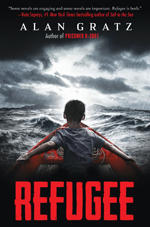 Three young people from different places and times—Josef, a Jewish boy in Nazi Germany in 1938; Isabel, a girl living near Havana under the dictatorship of Fidel Castro in 1994; and Mahmoud, living in war-torn Aleppo, Syria, in 2015—have the same goal: to flee their homelands with their families. This fast-paced, action-packed adventure story is also a compelling historical exploration of the plight of immigrants who take incredible journeys to survive, sustained by the quest for freedom and the hope of reaching a place in which their families can rebuild their lives.
Three young people from different places and times—Josef, a Jewish boy in Nazi Germany in 1938; Isabel, a girl living near Havana under the dictatorship of Fidel Castro in 1994; and Mahmoud, living in war-torn Aleppo, Syria, in 2015—have the same goal: to flee their homelands with their families. This fast-paced, action-packed adventure story is also a compelling historical exploration of the plight of immigrants who take incredible journeys to survive, sustained by the quest for freedom and the hope of reaching a place in which their families can rebuild their lives.
Ages 15+
Jane Unlimited. Kristen Cashore. 2017. Kathy Dawson/Penguin.
 Fulfilling a promise made to her adventurous Aunt Magnolia, her guardian who recently died, to visit Tu Revien if invited, 18-year-old Jane accompanies Kiran Thrash to the family’s island mansion and, thus, begins her heroine’s journey. Thrust into the midst of eccentric houseguests, she uncovers mysteries (art thefts, spies, and kidnapping) and unexpected truths in this five genre mash-up that turns everything Jane thought she knew about her world and the universe upside down.
Fulfilling a promise made to her adventurous Aunt Magnolia, her guardian who recently died, to visit Tu Revien if invited, 18-year-old Jane accompanies Kiran Thrash to the family’s island mansion and, thus, begins her heroine’s journey. Thrust into the midst of eccentric houseguests, she uncovers mysteries (art thefts, spies, and kidnapping) and unexpected truths in this five genre mash-up that turns everything Jane thought she knew about her world and the universe upside down.
Long Way Down. Jason Reynolds. 2017. Atheneum/Simon & Schuster.
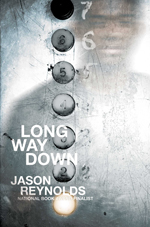 When his brother Shawn is shot and killed, 15-year-old Will knows the rules of the neighborhood: No Crying. No Snitching. Seek Revenge. Taking Shawn’s gun, he heads to the elevator to descend seven floors to the street. As the elevator stops at each floor, a different ghost from Will’s past, each a victim of gun violence, joins him and asks some hard questions. By the time he reaches the ground floor, has Will changed his plan to follow the rules? The ambiguous ending—“YOU COMING?— of Reynold’s beautifully-crafted free verse novel is startling and thought provoking.
When his brother Shawn is shot and killed, 15-year-old Will knows the rules of the neighborhood: No Crying. No Snitching. Seek Revenge. Taking Shawn’s gun, he heads to the elevator to descend seven floors to the street. As the elevator stops at each floor, a different ghost from Will’s past, each a victim of gun violence, joins him and asks some hard questions. By the time he reaches the ground floor, has Will changed his plan to follow the rules? The ambiguous ending—“YOU COMING?— of Reynold’s beautifully-crafted free verse novel is startling and thought provoking.
Soldier Boy. Kelly Hutton. 2017. Farrar Straus Giroux.
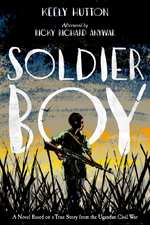 In 1989, at age 14, Ricky was abducted by Joseph Kony’s rebel army in a raid on his Ugandan village. Hutton gives a vivid account of the brutal training and horrors of combat missions that Ricky endured and survived over four years, while he remained determined to escape and return home. Interwoven into the narrative are chapters set in 2006, in which fictional 11-year-old Samuel, who is recuperating from battlefield wounds, distrusts his caregivers and the stranger (Ricky Richard Anywar, founder of Friends of Orphans), who promises to help him return home. An afterword by Anywar provides information about the challenges faced by former child soldiers and the work of Friends of Orphans.
In 1989, at age 14, Ricky was abducted by Joseph Kony’s rebel army in a raid on his Ugandan village. Hutton gives a vivid account of the brutal training and horrors of combat missions that Ricky endured and survived over four years, while he remained determined to escape and return home. Interwoven into the narrative are chapters set in 2006, in which fictional 11-year-old Samuel, who is recuperating from battlefield wounds, distrusts his caregivers and the stranger (Ricky Richard Anywar, founder of Friends of Orphans), who promises to help him return home. An afterword by Anywar provides information about the challenges faced by former child soldiers and the work of Friends of Orphans.
Who Killed Christopher Goodman? Allan Wolf. 2017. Candlewick.
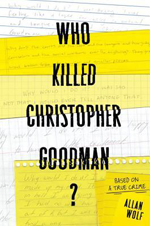 Teen Christopher Goodman was killed during Deadwood Days in Goldsburg, Virginia, in 1979. Doc and Squib, who discover Christopher’s body on a morning cross-country training run, as well as other classmates who interacted with Christopher during the last night of the festival, are plagued by thoughts that they may have played a role in his murder. Six narrators (including the killer) tell the story, which unfolds in poetry, prose, and play script entries. Memorial poems for Christopher Goodman written by classmates for their advanced literacy studies class provide the perfect ending to this tragic story, which is based on a true crime.
Teen Christopher Goodman was killed during Deadwood Days in Goldsburg, Virginia, in 1979. Doc and Squib, who discover Christopher’s body on a morning cross-country training run, as well as other classmates who interacted with Christopher during the last night of the festival, are plagued by thoughts that they may have played a role in his murder. Six narrators (including the killer) tell the story, which unfolds in poetry, prose, and play script entries. Memorial poems for Christopher Goodman written by classmates for their advanced literacy studies class provide the perfect ending to this tragic story, which is based on a true crime.
Nancy Brashear is Professor Emeritus of English from Azusa Pacific University, in Azusa, California. Carolyn Angus is former Director of the George G. Stone Center for Children's Books, Claremont Graduate University, in Claremont, California.
These reviews are submitted by members of the International Literacy Association's Children's Literature and Reading Special Interest Group (CL/R SIG) and are published weekly on Literacy Daily.